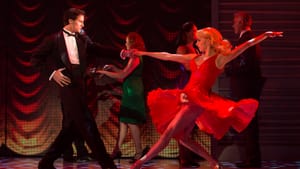Stay in the Loop
BSR publishes on a weekly schedule, with an email newsletter every Wednesday and Thursday morning. There’s no paywall, and subscribing is always free.
A nice Jewish girl in the Catskills
'Dirty Dancing' at the Academy of Music

There’s a mythology about the nice Jewish girl meeting the bad boy and finding, if not love and happiness, at least a sense of self. Herman Wouk’s Marjorie Morningstar was my introduction to this genre, and I did eventually meet my Noel Airman, although it was doomed not to last. Dirty Dancing, the film, was the second, which mirrored my discomfort with privilege and prejudice. They are both coming-of-age stories and simultaneously representations of class struggle.
Like Baby, the heroine of Dirty Dancing whose parents took her to Kellerman’s, I was dragged by my parents to one of those grand hotels in the Catskills, in my case, the Concord, on school vacations, and I, like Baby, hung out with the hired help rather than the other socially acceptable (to my parents) guests. Just imagine the family discussions.
The Catskills, also known as the Borscht Belt, was a vacation destination for New York and New Jersey Jews. There were grand hotels with lots to do, like learning the mambo and swimming, and entertainment — it’s where some of the best-known Jewish comedians honed their routines, though my parents wouldn’t let me see them, that was their version of dancing dirty. And there were, and still are, summer colonies where families could relax together away from the stresses of the city.
Can this dancer be saved?
Dirty Dancing, the film, which was released in 1987 and set in 1963, is one of those movies I’ve seen so often I can practically recite the lines. The story centers on Frances “Baby” Houseman, a young woman who wants to save the world, while her family just wants to have fun on their two-week vacation. At Kellerman’s, Baby discovers the world of college kids who have been hired to keep the young girls happy, and the grittier world of Johnny Castle and his friends, the hired dancers and staff, who introduce her to dirty dancing. Baby naively thinks she can save Johnny and his friends, and when she tries, she finds herself at odds with her family. And through it all she learns to dance and eventually to stand up for what she believes in.
Baby was the anchor of the movie. We watched her struggle to make choices between her family and her newfound love. Her learning to dance was our struggle to take on something new and difficult.  Unfortunately in Dirty Dancing: The Classic Story on Stage, currently at the Academy of Music, Baby’s story gets lost in the shuffle, and it’s hard to find something to anchor the story. There was a moment, however, at the end of the show when I wanted the cast to dance through the aisles as they do in the movie, and I think I would have forgiven them all the rough spots of the evening, if they had done that.
Unfortunately in Dirty Dancing: The Classic Story on Stage, currently at the Academy of Music, Baby’s story gets lost in the shuffle, and it’s hard to find something to anchor the story. There was a moment, however, at the end of the show when I wanted the cast to dance through the aisles as they do in the movie, and I think I would have forgiven them all the rough spots of the evening, if they had done that.
The sincerest form of flattery
Mostly the show reminded me of one of those tableaux vivants in which people dressed up and imitated classic works of art. The show tries so hard to imitate the movie that it never quite finds its own personality. Perhaps having the original writer, Eleanor Bergstein, write the stage play was not the best choice. Whether Bergstein was too close to the material to find a way to rework it, or didn’t understand the different medium in which she was working, sticking so faithfully to the film script left the stage play feeling jumpy and disjointed.
There were moments that made me laugh and marvel. A sex scene hinted at by dimming the lights onstage and showering the audience with sparkling lights reminded me of the lowering the shades on sex scenes in early movies. And projections of greenery and water on a scrim through which we could see the dancers practice their routine as if in a field or a lake worked wonderfully.
The cast handled their roles well, and it may be unfair to compare the stage actors to their filmic counterparts. But the show goes out of its way to make everyone but Johnny look like the original, so it’s fair game. Patrick Swayze is a hard act to follow, and while Samuel Pergande as Johnny Castle was a good dancer, he never exuded the danger and sexuality of Swayze’s Johnny. Gillian Abbott as Baby, in the role Jennifer Grey created before she had plastic surgery and tanked her career, had Grey’s curly hair but not her effervescence. Jenny Winton’s Penny did seem like she might have been a Rockette, and Emily Rice, as Lisa, Baby’s sister, does a fine job with the awful Hula song.
Oddnesses and anachronisms
There were some oddities as well. In a show billed as a musical, there were only two real singers, and they weren’t the lead characters. Jennlee Shallow and Doug Carpenter brought some familiar songs — “(I’ve Had) The Time of My Life,” “In the Still of the Night” — to life.
And then there were the references to the social movements of the times. John F. Kennedy and Freedom Marches and singing protest songs around a campfire were all relevant to the times, even if they didn’t feel fully integrated into the story. The clientele of the resort seemed integrated, which it wouldn’t have been, and yet relegating minorities to just the hired help in today’s world has its own set of issues.
Much as I loved the movie, the reality is that dirty dancing is what two-year-olds do on YouTube today, so it’s hard to think of it as shocking. Would bringing the story into the present have worked? I’m not sure. But a more tightly focused script would have helped actors and audience alike to appreciate the period piece that it is.
What, When, Where
Dirty Dancing: The Classic Story on Stage, by Eleanor Bergstein. James Powell directed. Choreography by Michele Lynch based on the original choreography by Kate Champion. Through April 5, 2015 at Academy of Music, Broad and Locust Streets, Philadelphia. 215-893-1999 or www.kimmelcenter.org.
Sign up for our newsletter
All of the week's new articles, all in one place. Sign up for the free weekly BSR newsletters, and don't miss a conversation.
 Naomi Orwin
Naomi Orwin